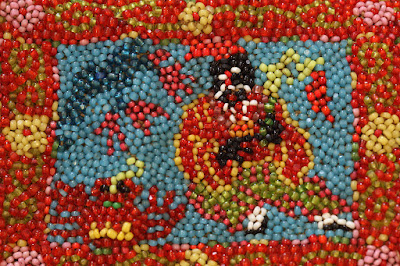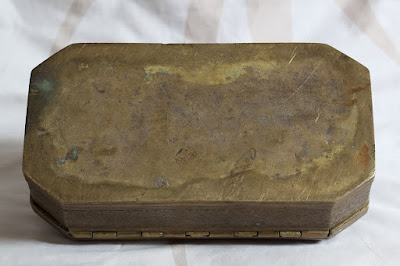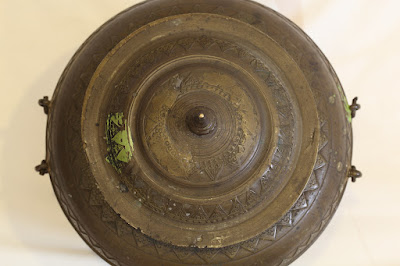The earliest bead work was stitched with silk threads on Chinese silk, also used for embroidery. Later, long-piled furry velvet was used as the base material. Subsequently, when metallic threads became scarce, beads were embroidered upon short-piled velvet on which the beads stood out better.
Originally, the beads used were of European manufacture, mainly from eastern Europe in the style of Venetian glass. Unlike the bead work of many other cultures, traditional Nyonya bead work used glass beads ranging from 0.5 to less than 1 millimetre in diameter. These micro beads were threaded with waxed silk threads because no needle could pass through them.
The types of beads varied. They could be translucent, opaque, faceted or even oxidized to a sheen. Victorian England excelled in bead work, fashions travelled to other places, albeit with a time lag in styles. Unsurprisingly then, together with Venetian and Bohemian styles, Victorian found its way into Nyonya bead work together with significant Neo Rococo and Art Deco flavours.
Foreign beads which were traded in Southeast Asia by West Asian, Indian and Chinese travellers in the earlier periods were generally large. These beads are sometimes referred to as 'trade wind' beads because the traders sailed according to the winds. With mechanization, tiny beads known as 'seed beads' became available. These small, hard perforated objects played an important role in world trade and have been the medium of transfer of art styles to faraway places. The Nyonya used to purchase glass or metal beads from itinerant neighbourhood vendors who spooned out loose beads or offered them as threaded bunches. However, only plastic ones are now available unless old glass ones are recycled.
A major Peranakan bead work item is beaded slippers (kasut manik). However, the highly intricate art of Nyonya bead work was not confined to slippers. Other items such as handbags and belts (as shown in pictures below), tapestries and bedspreads displayed a wider and more elaborate use of their skills. Baba (Straits Chinese men) had absolutely nothing to do with the manufacture of beaded objects.
Pictures below show a beaded wedding belt with a silver buckle, worn by both brides and grooms in my collection.
Length : 76.5cm
The Nyonya employed three methods of beading : stringing, threading and stitching, where the last being the mostly widely used. Beads were strung mainly for tassels and fringes. Threading beads was the most difficult, especially when executed without a supporting frame, considerable care was required in handling the beads, which ran along the threads unless knotted down. Almost like making lace, multiple threads were used simultaneously to form patterns and under an unskilled hand, the threads could entangle.
Bead work was produced on frames that varied from simple wooden contraptions to elaborately lacquered devices, usually accompanied by a stand with drawers. For stitching, the backing material ranged from velvet to fine canvas, gauze and netting. Generally, all the beads were stitched down in the same direction so as to give a smooth surface. An even tension was needed, as beads may pucker if not anchored down properly.
Originally, the beads used were of European manufacture, mainly from eastern Europe in the style of Venetian glass. Unlike the bead work of many other cultures, traditional Nyonya bead work used glass beads ranging from 0.5 to less than 1 millimetre in diameter. These micro beads were threaded with waxed silk threads because no needle could pass through them.
The types of beads varied. They could be translucent, opaque, faceted or even oxidized to a sheen. Victorian England excelled in bead work, fashions travelled to other places, albeit with a time lag in styles. Unsurprisingly then, together with Venetian and Bohemian styles, Victorian found its way into Nyonya bead work together with significant Neo Rococo and Art Deco flavours.
Foreign beads which were traded in Southeast Asia by West Asian, Indian and Chinese travellers in the earlier periods were generally large. These beads are sometimes referred to as 'trade wind' beads because the traders sailed according to the winds. With mechanization, tiny beads known as 'seed beads' became available. These small, hard perforated objects played an important role in world trade and have been the medium of transfer of art styles to faraway places. The Nyonya used to purchase glass or metal beads from itinerant neighbourhood vendors who spooned out loose beads or offered them as threaded bunches. However, only plastic ones are now available unless old glass ones are recycled.
A major Peranakan bead work item is beaded slippers (kasut manik). However, the highly intricate art of Nyonya bead work was not confined to slippers. Other items such as handbags and belts (as shown in pictures below), tapestries and bedspreads displayed a wider and more elaborate use of their skills. Baba (Straits Chinese men) had absolutely nothing to do with the manufacture of beaded objects.
Pictures below show a beaded wedding belt with a silver buckle, worn by both brides and grooms in my collection.
Length : 76.5cm
The Nyonya employed three methods of beading : stringing, threading and stitching, where the last being the mostly widely used. Beads were strung mainly for tassels and fringes. Threading beads was the most difficult, especially when executed without a supporting frame, considerable care was required in handling the beads, which ran along the threads unless knotted down. Almost like making lace, multiple threads were used simultaneously to form patterns and under an unskilled hand, the threads could entangle.
Bead work was produced on frames that varied from simple wooden contraptions to elaborately lacquered devices, usually accompanied by a stand with drawers. For stitching, the backing material ranged from velvet to fine canvas, gauze and netting. Generally, all the beads were stitched down in the same direction so as to give a smooth surface. An even tension was needed, as beads may pucker if not anchored down properly.






























